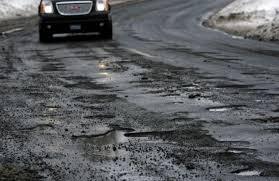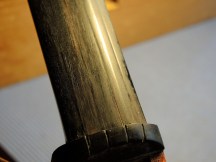Occasionally, I have a job come in that seems to make an extreme sport out of basic violin maintenance. This is the kind of job that I prefer to turn over quickly, since my clients are serious musicians, and most find it difficult to be parted with their instruments for any length of time. Usually, it doesn’t even occur to me to take out my camera, because, let’s face it, fingerboard planing is so “ho humm” for us fiddle fixers. Which is NOT to say that it doesn’t require absolute skill and precision to execute properly! In that it is a basic procedure, it is a little like buying new tires for your car, although having your fingerboard planed will probably cost less and yield results that you will actually notice. I hate buying tires for my car.
I’m making a serious comparison here! The fact is that driving your car and playing your instrument both impact the surface in play. In the former case, we replace the tires when excessive wear is evident, or else we call the DPW:
In the latter case, we develop superior finger callouses, and then resurface the fingerboard as needed.
Excessive wear in a fingerboard can manifest as ruts, caused by pressing the strings against the surface of the fingerboard, and as pits between the strings, where the player’s fingers, with their superb callouses, land. A quick sighting down the neck reveals the telltale washboard effect.
Closer inspection shows serious pitting and string ruts all the way up the fingerboard.
This is lovely old German cello is a pretty extreme example – perfect for demonstration purposes! The fact is that fingerboard wear happens gradually. Often the player makes subtle adjustments over time to compensate for the discrepancies in the playing surface. The informed player knows to have the board checked periodically, and may even detect the symptoms of a worn board before it becomes unmanageable. Everyone else just blames the soundpost!
It’s true, the soundpost seems to take the blame whenever something mysterious is happening with an instrument. That’s why a good luthier is also a diagnostician. A worn fingerboard can cause buzzing, obviously, but it can also result in the loss of clarity in tone production. And, it can wreak havoc with intonation. Can’t seem to nail those fifths anymore? Hmmm.
Fingerboards are generally made out of ebony – a very hard, dense wood that is black, sometimes with paler streaks. The fingerboard is meant to be resurfaced as needed. I have some clients that have this done every couple of years. Others go longer. Sometimes, as in the case of my German cello, MUCH longer!
The shape of the fingerboard is carefully calculated. From end to end it has a gentle “scoop” which enables the string to vibrate freely from whatever point it’s fingered. Too little scoop and the string buzzes, too much scoop and the string is difficult to press down. The arc across the fingerboard is also shaped precisely, using a template. The fingerboard arc needs to correspond properly to the bridge arc, so that the player experiences comfortable and even fingering.
The fingerboard is shaped with a sharp plane. The first few cuts into a badly worn board are always revealing.
Here, I’m checking the arc against my template.
To evaluate the scoop, I first use a long straight edge. Then I use a short straight edge to detect any discrepancies. I like to see a sliver of light under the short edge, all along the length of the board. That’s my favorite plane for the job – it’s a Lie-Nielsen block plane. I start with a heavier cut. Then, as I approach the desired shape, I back the blade off and proceed with a very light cut. This leaves a minimum of finish work to do with a scraper and fine sandpaper.
The fingerboard is polished with mineral oil and a bit of tripoli for a smooth, consistent surface.
An accurate fingerboard can make a huge difference for a player. One happy client, Rebecca Hartka, had this to say recently:
Playing in tune is suddenly soo much easier since I just had my fingerboard smoothed down. It’s amazing to me that putting my fingers down over and over again can literally cause dips in my ebony fingerboard! And how much mayhem a wobbly fingerboard can cause in note consistency. Thanks Stacey Styles for the beautiful job! Phew!
All dressed up now, and ready to go!











